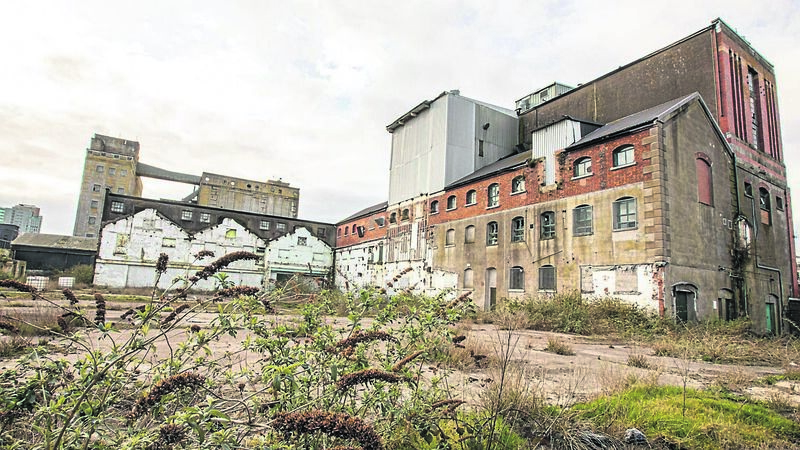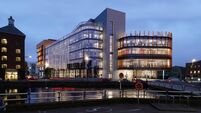Derelict Sites: Heritage buildings are key to reviving our cities

Odlums: We propose that this is transformed to a city sanctuary and reflection space filled with culture, performance, drama and music. With strong ties to local creatives it will be attractive for both a national and international audience. This modular and adaptable space should seamlessly connect with the River Lee. Words: Frank O’Connor & Jude Sherry, anois.org
Dublin’s iconic Iveagh Markets in the Liberties are a bustling commercial hub once again after decades of lying closed and derelict.
The Capital’s Royal City of Dublin Hospital thrives as a south inner-city social housing project.
Families pass each other up and down the stone-stepped cascade stairway to the street from the once boarded up front doors of the late Victorian Baggot Street property.
In Cork city, neighbours lean down or up to greet each other cheerily through half-opened sash windows on the upper levels of period properties all along North Main St.
And in the centuries-old sawmills behind Bridewell Garda Station, boutique businesses thrive where once lay for years a roofless ruin overgrown with weeds, locked away behind locked rusted gates and splashed with thick white and grey streaks of pigeon droppings.
And down on the quays, the huge old Odlums complex is now another of Ireland's thriving social housing hubs, surrounded by small shops and play areas for children.
This is the dream but the reality is far more grim.
These iconic properties in Dublin and Cork city centres are part of a huge collection of architecture wrecks that haunt the streets of almost every major town and city.
And every so often, someone throws up their arms and decries the fact our cities are filled with so many derelict buildings.
But while authorities are now more proactive on the issue than in previous years, there are those who think they are just not doing enough.

Step forward Cork-based urban design and sustainability consultants Frank O’Connor and Jude Sherry as the latest people to raise their arms on the issue, and one the Irish Examiner has frequently covered, including a major report in 2019.
After years of living abroad, particularly in Amsterdam, they returned to Ireland in 2018, bringing with them a vision for urban renewal that borders on the zealous.
They appear to be in the same ideological space occupied by a growing number of urban renewal movements, including organisations like 3Space.
The London-based NGO was launched in 2010 to increase the provision of “spaces for public good” in cities as a direct response to the increase in vacant commercial premises following the crash.
The movements shouldn’t, however, be confused with the urban renewal projects in American cities in the 1950s and '60s, which led to the displacement of hundreds of thousands of people.
Returning back to Ireland in 2018 after years abroad, they were shocked by the level of homelessness and dereliction in the country in general when they returned.
After two years of what they call “immersive research” into the subject, they started sharing images of derelict properties on Twitter last June of properties in Cork city centre in particular.
And last month (March), they produced a detailed report on dereliction in the city, which they believe is representative of the entire country.
In a nutshell, they believe existing mechanisms — both legal and constitutional — should be used by local authorities to force owners to do something with their properties or lose them “for the great good” of society to combat a “contagion”.
They say dereliction is “sucking the economic potential out of all our cities, towns and villages” and is “making core urban areas unliveable”.
They say it is also “eating away at communities, eroding our sense of place and jeopardising the viability of local businesses and traders”.
And they say: “Dereliction is such an epidemic in Ireland that many of us have become normalised to decaying and collapsing buildings.”
They also demand to know why, in their words, a small number of property owners are allowed to “destroy our cities” through “disrespect and neglect”.
They have been painstakingly recording the details of derelict properties within a 2km radius of Cork city centre since 2018.
They have counted 340 derelict properties and are calling on organisations including Cork City Council to bring each and every one of them back to life within — ideally — five years.
Indeed, they want Cork to be the first city in Ireland to eliminate dereliction.
Ms Sherry said: “What we would like to see happening on a national level is legislation to deal with long-term vacancy as they have in Amsterdam.
“If you have a residential property that is empty for over a year, the councils in Amsterdam can put a tenant in there without your agreement.
“The owner still owns the property but it gets used, and we also have very strict building controls.
“We'd like to see stricter enforcement of the current building controls.
“Tackling dereliction is key to making the city more liveable.
“It makes it safer and it makes the city attractive for families and people of all ages and backgrounds to come and live in.”
Herself and Mr O’Connor say that what is needed here is “proactive leadership” on the part of Cork City Council to “maximise the impact of tools and measures available, in particular through Compulsory Purchase Orders (CPOs), dereliction levies”.
They also say that Cork City Council could raise a total of €2.1m annually on the 95 properties on its register of derelict properties.
And they say this figure could be multiplied a number of times if the council’s list were to include — at the very least — all the extra properties they have identified.
They dispute the idea that building regulations can be a barrier to restoring derelict buildings.
Indeed, they maintain that public perception of building regulations is “frequently inaccurate” and serves to put many people off renovating old, derelict or long-term vacant properties.
They suggest private property rights “can be limited” by “social justice and common good”. And they say “the constitution is there to ensure our rights to social justice and the common good” and that “this is for the benefit of all citizens” and . . . “not just land and property owners”.
Cork-based Grade 1 conservation architect Oisin Creagh says one of the reasons people are reluctant to invest in derelict properties in the city centre, especially with mixed commercial and residential use, can be the additional work and cost associated with meeting fire regulations.
It can often be far more cost-effective for a landlord to close the upper floors above a shop and maximise retail space on the ground floor, because the cost of upgrading fire escapes and other such safety measures can simply be too expensive, to make it viable.
“There is a fine balance, and it is certainly demand-driven," Mr Creagh, one of Ireland's leading conservation architects, said.
“I’ve been involved in a number of buildings that have gone through the whole conversion and restoration process, including a few protected structures on the Grand Parade, so it is certainly possible.
“However, if rental income is low, and the costs of doing up the properties are high, unfortunately, it doesn't always make commercial sense to tackle some of these properties.
“The city council are doing enormous work to make living in the city more attractive as far as they can.
“There is progress being made with tackling abandoned derelict properties and once that continues, it has a knock-on effect in bringing more people back into the city.”
He points out there is also now a new dynamic at work in the city, caused by the pandemic.
“There is also uncertainty about how many businesses will have all staff in offices in the future.
“And this is adding a whole other dynamic.”
He added: “Often owners of seemingly abandoned properties have a plan, and are going through a sometimes complicated planning or legal process.
“I’ve worked on properties that were listed as derelict sites, and we worked with owners and developed those properties successfully.
“Certainly in some cases, it can help to put pressure on owners to deal with sites or part with them.
“There’s a functional system in place and it would be unfair to say the city council isn’t addressing the issue.
“Again, the city council has limited resources to tackle what is a big and often complex problem.
"The living city initiative urban renewal scheme has certainly seen lights back on upstairs in buildings in town."

In response to Mr O’Connor and Ms Sherry’s report, a spokesperson for Cork City Council said: “There is no simple solution to dereliction in Irish cities and towns.
“For Irish local authorities, it involves painstaking ongoing engagement and collaboration with owners, legal teams, auctioneers, extended families. sometimes receivers, housing bodies, and potential developers to progress sites.
“When Cork City Council intervenes around a derelict site, there is always something that can be done but none of that can happen as quickly and easily as many of us would wish.
“Cork City Council always seeks to work with an owner to try to remove the dereliction through a cooperative approach.
“For example, where an owner is actively pursuing a planning application, an owner needs to be allowed to follow that through.
“There are a variety of commonplace complexities that can delay or frustrate a long term solution to dereliction: probate difficulties, title difficulties which prevent (or) can hinder the owner from selling a site, access to finance, multiple owners, sites in receivership or legal dispute.
“None of these issues are insurmountable, however they cannot be resolved quickly.”
The council says there are currently 95 sites on its derelict sites register and that it is “actively working” with all of them.
And they stress plans are advancing for a number of high profile sites, such as St Kevin’s — the eyesore iconic former mental health institution that has been hit by a series of fires.
In addition, the council says it has commissioned what it is calling a “city centre economic and revitalisation strategy”.
And they say this will “consider the instruments needed to squarely address the fabric of the city”.
Whether or not the strategy leads to the restoration of sites like the old sawmills behind Bridewell garda station or the old Odlums building any time soon remains to be seen.
But for now, it has taken a pair of idealists to help kickstart (again) debate on a decades-old Cork city centre problem.

Are you tired of seeing dereliction every time you leave your front door? Are you unhappy with the cultural acceptance of ‘that’s the way things are’? Welcome to the club.
Sadly dereliction has become part of the fabric of where we live. Some days it really gets us down, it’s a constant reminder of wasted potential. What should be homes for children, families, or individuals, instead lay long-term derelict, alongside potential play and work spaces. Decaying over time, eating away at the wellbeing of the community, it really makes no sense.
Imagine a city where dereliction is turned into an opportunity to create a liveable urban environment where everyone can thrive with no exceptions made, where experience is prioritised over consumption and where we make the most of the resources we have.
Then imagine the lives of derelict buildings extended through taking advantage of their designed in durability by repairing and repurposing them, into something beautiful, functional and meaningful that carries forward significant heritage, while taking advantage of modern good practice.
Our case study of 300-plus properties in Cork city provides evidence that dereliction can be eradicated. Our international best practice research indicates that Cork would thrive as a result.
This new Cork should not be a follower of other cities, not be dependent on corporates, global brands or extractive economic models. It should simply be itself, celebrate who it is, its built environment, its natural resources, its landscape, its people, its heritage while focusing on indie, local businesses.
Who are we? We are Jude and Frank, system designers behind the agency anois.org. We’ve 50 years combined working on sustainability projects all over the world. Having lived abroad for a few decades, we fell in love with the vibrancy of Cork City in 2017. We took the plunge and moved to historic Blackpool in 2018. The friendliness of Corkonians has been a wonderful daily tonic as we’ve navigated the city. On the flip side, we’ve really struggled with the homelessness crisis, dereliction and the decaying heritage.
We consider ourselves urban explorers and have walked and documented many European cities. In doing so, we scope out opportunities to apply our urban RestPlayWork model, based on our belief that everyone deserves a home (rest), a space they can have fun (play), and access to just, meaningful employment (work).
From day one, we walked the city, every street, laneway and cul-de-sac recording our experiences, everything from buildings to public seating to heritage to play spaces. We started sharing our findings last summer (on Twitter), and started an ongoing thread on dereliction which has garnered millions of views. We have shared over 300 properties to date, all within 2km of the city centre island.
On our daily walk, the human impact of dereliction really struck us, particularly its effect on everyone’s quality of life. We also realised that dereliction had long been framed as an unsolvable problem in Ireland. Using this as motivation, we set out to bust 10 commonly held Irish dereliction myths. Through collecting and analysing all publicly available data on our dereliction thread we found some startling results. Dereliction was solvable. We just needed the political and cultural will.

Now let’s have a look at some global trends. Cities that retain their built, cultural, and natural heritage thrive because the discerning tourist and transient tech worker really value this uniqueness. Immediately Cork is in an advantageous position, as it truly has a distinctive landscape, heritage, and authenticity. Its significant buildings and streetscapes can be restored to become huge marketable traits. Plus, it’s cheaper and more sustainable to repurpose existing buildings, as shown through the latest Pritzker Architecture Prize.
Added to this, Cork has the ability to quickly densify by bringing existing vacant spaces back into use. Combined, the knock-on effect on the economy will be massive — more people, more services, more money to reinvest and so on.
Let’s look at another trend. The future of manufacturing is urban and circular, using local resources to maximise the value creation process. How about we enable creatives such as designers, artists, and makers to take over derelict spaces and co-create with all Corkonians this new urban economy, stimulating local production houses to create sustainable furniture, personal care, food, clothing, and other goods?
Now imagine Cork City in 10 years’ time, a flagship of rapid transformation and sustainable densification, designed with and for the people. The unnecessary dereliction blight that was sucking the economic potential out and jeopardising the viability of local businesses and traders is gone. Debunking the myth about retrofitting being more expensive than buying a new suburban home has had a radical impact.
Living over the shop is back in fashion; hundreds of properties have been bought back into use. Plans have been realised for 100 pocket parks, 1,000 benches, and 10,000-strong urban forest, all funded from the millions collected by Cork City Council through the dereliction levy. There is even a prioritisation of experience over the outdated model of viewing urban centres as just spaces to consume.
With many families returning to Cork city centre, the sound of cars has given way to the sounds of children playing. It is now cheaper, more convenient and more sustainable to live in the centre, honing a strong sense of place with intergenerational city living now the norm.
Corkonians are thriving from their yearly saving of €10,000 by getting rid of that second car, and another €5,000 with lower mortgage repayments. They have more money in their pocket every month to spent supporting local business and on pastimes. The resulting café boom has enabled many small businesses to thrive again after those horrible Covid years.
Corkonians have fallen back in love with their city. It is liveable, safe, healthy, beautiful, and productive and has become a global beacon for 21st century urban economic resilience and innovation. This new Cork invites everyone to RestPlayWork. Dreams can come true.













